本文介紹了CS42L37主要特性,方框圖, 典型連接框圖以及CS42L37評(píng)估板主要特性, 評(píng)估系統(tǒng)方框圖以及評(píng)估板詳細(xì)電路圖與智能音頻CODEC應(yīng)用框圖.
CS42L37是Cirrus公司的高度集成的低功耗音頻和電話CODEC,主要用于手持應(yīng)用如智能手機(jī)和超小型移動(dòng)計(jì)算機(jī). CS42L37具有靈活的時(shí)鐘架構(gòu),時(shí)鐘頻率有6, 12, 24, 13, 26, 19.2, 或38.4 MHz,具有立體聲ADC,支持雙路模擬或數(shù)字MIC,雙路MIC偏壓發(fā)生器,4個(gè)DAC耦合到5個(gè)輸出. 立體聲ADC動(dòng)態(tài)范圍91dB,THD+N為-85dB,2:1立體聲模擬輸入復(fù)接器, 立體聲DAC到線路輸出動(dòng)態(tài)翻番97dB,THD+N為-86dB,H類放大器.
The CS42L73 is a highly integrated, low-power, audio and telephony CODEC for portable applications such as smartphones and ultra mobile personal computers.
The CS42L73 features a flexible clocking architecture, allowing the device to utilize reference clock frequencies of 6, 12, 24, 13, 26, 19.2, or 38.4 MHz, or any standard audio master clock. Up to two reference/master clock sources may be connected; either one can be selected to drive the internal clocks and processing rate of the CS42L73.
Thus, multiple master clock sources within a system can be dynamically activated and de-activated to minimize system-level power consumption.
Three asynchronous bidirectional serial ports (Auxiliary, Audio, and Voice Serial Ports) support multiple clock domains of various digital audio sources or destinations. Three low-latency, fast-locking, integrated high-performance asynchronous sample rate converters synchronize and convert the audio samples to the internal processing rate of the CS42L73.
A stereo line input or two mono (one stereo) microphone (MIC) inputs are routed to a stereo ADC. The MIC inputs may be selectively pre-amplified by +10 or +20 dB. Two independent, low-noise MIC bias voltage supplies are also provided. A programmable gain amplifier (PGA) is applied to the inputs before they reach the ADC.
The stereo input path that follows the stereo ADC begins with a multiplexer to selectively choose data from a digital MIC interface. Following the multiplexer, the data is decimated, selectively DC high-pass filtered, channelswapped or mono-to-stereo routed (fanned-out), and volume adjusted or muted. The volume levels can be automatically adjusted via a programmable Automatic Level Control (ALC) and noise gate.
A digital mixer is utilized to mix and route the CS42L73’s inputs (analog inputs to ADC, digital MIC, or serial ports) to outputs (DAC-fed amplifiers or serial ports). There is independent attenuation on each mixer input for each output.
The processing along the output paths from the digital mixer to the two stereo DACs includes volume adjustment and mute control. A peak-detector can be used to automatically adjust the volume levels via a programmable limiter.
The first stereo DAC feeds the stereo headphone and line output amplifiers, which are powered from a dedicated positive supply. An integrated charge pump provides a negative supply. This allows a ground-centered analog output with a wide signal swing, and eliminates external DC-blocking capacitors while reducing pops and clicks. Trilevel Class-H amplification is utilized to reduce power consumption under low-signal-level conditions. Analog volume controls are provided on the stereo headphone and line outputs.
The second stereo DAC feeds several mono outputs. The left channel of the DAC sources a mono, differentialdrive, speakerphone amplifier for driving the handset speakerphone. The right channel sources a mono, differential- drive, earphone amplifier for driving the handset earphone. The right channel is also routed to a mono,differential-drive, speakerphone line output, which may be connected to an external amplifier to implement a stereo speakerphone configuration when it is used in conjunction with the integrated speakerphone amplifier.
The CS42L73 implements robust power management to achieve ultra-low power consumption. High granularity in power-down controls allows individual functional blocks to be powered down when unused. The internal low dropout regulator (LDO) saves power by running the internal digital circuits at half the logic interface supply voltage (VL/2). In a system with an existing high-efficiency supply at VL/2, the internal LDO may be disabled and the digital circuits powered directly by the external VL/2 supply.
A high-speed I2C control port interface capable of up to 400 kHz operation facilitates register programming.
The CS42L73 is available in space-saving 64-ball WLCSP and 65-ball FBGA packages for the commercial (-40° to +85℃) grade.
CS42L37主要特性:
Product Overview
??Stereo ADC
??Dual Analog or Digital MIC Support
??Dual MIC Bias Generators
??Four DACs Coupled to Five Outputs
Ground-Centered Stereo Headphone Amp.
– Ground-Centered Stereo Line Output
– Mono Ear Speaker Amplifier
– Mono 1 W Speakerphone Amplifier
– Mono Speakerphone Line Output for Stereo Speakerphone Expansion
??Three Serial Ports with Asynchronous Sample Rate Converters
??Digital Audio Mixing and Routing
Ultra Low Power Consumption
??3.5 mW Quiescent Headphone Playback
CS42L37應(yīng)用:
??Smart Phones, UMPCs, and MIDs
System Features
??Native (no PLL required) Support for 6/12/24 MHz, 13/26 MHz, and 19.2/38.4 MHz Master Clock Rates in Add. to Typ. Audio Clock Rates
??Integrated High-efficiency Power Management Reduces Power Consumption
– Internal LDO Regulator to Reduce Internal Digital Operating Voltage to VL/2
Step-down Charge Pump Provides Low Headphone/Line Out Supply Voltage
– Inverting Charge Pump Accommodates Low System Voltage by Providing Negative Rail
for HP and Line Amp
??Flexible Speakerphone Amplifier Powering
– 3.00 V to 5.25 V Range
– Independent Cycling
??Power Down Management
– Individual Controls for ADCs, Dig. MIC Interface, MIC Bias Generators, Serial Ports, and Output Amplifiers & Associated DACs
??Programmable Thermal Overload Notification
??High-speed I2C? Control Port (400 kHz)
Stereo Analog to Digital Features
??91 dB Dynamic Range (A-wtd)
??-85 dB THD+N
??Independent ADC Channel Control
??2:1 Stereo Analog Input MUX
??Stereo Line Input
– Shared Pseudo-differential Reference Input
??Dual Analog MIC Inputs
– Pseudo-diff. or Single-ended
– Two, Independent, Programmable, Lownoise, MIC Bias Outputs
– MIC Short Detect to Support Headset Button
??Analog Programmable Gain Amplifier (PGA) (+12 to -6 dB in 0.5 dB steps)
??+10 dB or +20 dB Analog MIC Boost in Addition to PGA Gain Settings
??Programmable Automatic Level Control (ALC)
– Noise Gate for Noise Suppression
– Progr. Threshold & Attack/Release Rates
Dual Digital Microphone Interface
??Programable Clock Rate
– Integer Divide by 2 or 4 of Internal MCLK
Stereo DAC to Headphone Amplifier
??94 dB Dynamic Range (A-wtd)
??-81 dB THD+N into 32 ?
??Integrated Step-down/Inverting Charge Pump
?Class H Amplifier - Automatic Supply Adj.
– High Efficiency
– Low EMI
??Pseudo-differential Ground-centered Outputs
??High HP Power Output at -70/-81 dB THD+N
– 2 x 17/8.5 mW into 16/32 ??@ 1.8 V
??Pop and Click Suppression
??Analog Vol. Ctl. (+12 to -50 dB in 1 dB steps; to -76 dB in 2 dB steps) with Zero-cross Trans.
??Digital Vol. Ctl. (+12 to -102 dB in 0.5 dB steps) with Soft-ramp Transitions
??Programmable Peak-detect and Limiter
Stereo DAC to Line Outputs
??97 dB Dynamic Range (A-wtd)
??-86 dB THD+N
??Class-H Amplifier
??Pseudo-differential Ground-centered Outputs
??1 VRMS Line Output @ 1.8 V
??Pop and Click Suppression
??Analog Vol. Ctl. (+12 to -50 dB in 1 dB steps; to -76 dB in 2 dB steps) with Zero-cross Trans.
??Digital Vol. Ctl. (+12 to -102 dB in 0.5 dB steps) with Soft-ramp Transitions
??Programmable Peak-detect and Limiter
Mono DAC to Ear Speaker Amplifier
??High Power Output at -70 dB (0.032%) THD+N
– 45 mW into 16??@ 1.8 V
??Pop and Click Suppression
??Digital Vol. Ctl. (+12 to -102 dB in 0.5 dB steps) with Soft-ramp Transitions
??Programmable Peak-detect and Limiter
Mono DAC to Speakerphone Amplifier
??High Output Power at ≤?1% THD+N
– 1.18/0.84/0.66 W into 8??@ 5.0/4.2/3.7 V
??Direct Battery-powered Operation
??Pop and Click Suppression
??Digital Vol. Ctl. (+12 to -102 dB in 0.5 dB steps) with Soft-ramp Transitions
??Programmable Peak-detect and Limiter
Mono DAC to Speakerph. Line Output
??84 dB Dynamic Range (A-wtd)
??-75 dB THD+N
??High Voltage (1.53 VRMS @ VA = 1.8 V, VP =3.7 V) Line Output to Ensure Maximum Output from a Wide Variety of External Amplifiers
??Pop and Click Suppression
??Digital Vol. Ctl. (+12 to -102 dB in 0.5 dB steps) with Soft-ramp Transitions
??Programmable Peak-detect and Limiter
Serial Ports
??Three Independent Serial Ports: Auxiliary, Audio, and Voice
??8.00, 11.025, 12.00, 16.00, 22.05, 24.00, 32.00, 44.10, and 48.00 kHz Sample Rates
??All Ports Support Master or Slave Operation with I2S Interface
??Auxiliary and Voice Ports Support Slave Operation with PCM Interface
??Auxiliary and Audio Ports are Stereo-Input/Stereo-Output to/from Digital Mixer
??Voice Port is Mono-Input/Stereo-Output to/from Digital Mixer
??Integrated Asynch. Sample Rate Converters
圖1.CS42L37方框圖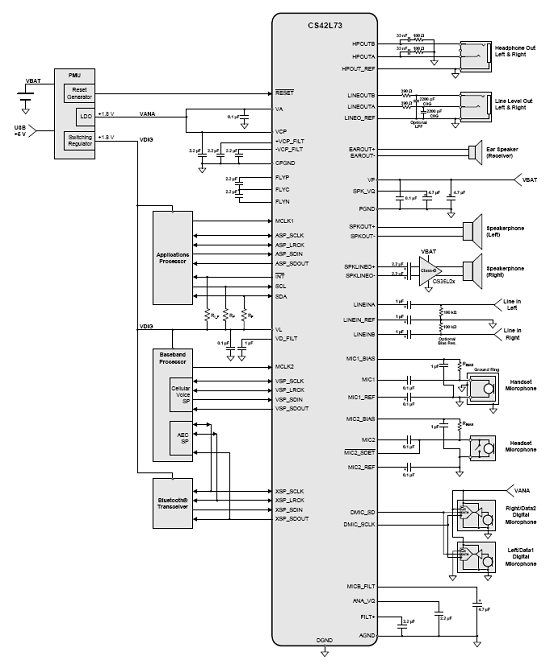
圖2.CS42L37典型連接框圖
CS42L37評(píng)估板
The CDB42L73 board is a dedicated platform for testing and evaluating the CS42L73, an ultralow power mobile audio and telephony CODEC.
To allow comprehensive testing of CS42L73 features and performance, extensive hardware and software configurable options are available on the CDB42L73.
Hardware options, such as power-supply settings, are configured via jumpers on the stake headers. Software options, such as registry settings for the CS42L73, are configured with the FlexGUI software, which communicates with the CDB42L73 via USB from a Windows? compatible computer. In addition, digital I/O headers on the CDB42L73 allow external control signals (for example, an external DSP or microcontroller) to configure and interface with the CS42L73 and other devices directly without the use of FlexGUI.
The CDB42L73 also serves as a good component and layout reference for the CS42L73.
CS42L37評(píng)估板主要特性:
? Analog Inputs
– Line-level In via 2x mono RCA jacks
– Microphone In via 2x mono 1/8” jacks
? Analog outputs
– Headphone out via 1x stereo 1/8” jack
– Line-level out via 2x mono RCA jacks
– Earphone out via terminal block
– Speakerphone out via terminal blocks
? S/PDIF interface via RCA/optical jacks
– Input: CS8416 digital audio receiver
– Output: CS8406 digital audio transmitter
? External digital I/O via stake headers
– Digital mic in
– Serial audio port I/O
– External I2C? control port I/O
? Flexible power-supply configuration
– USB, external power supply, or battery
? FlexGUI software control
– Windows? compatible
– Predefined and user-configurable scripts
圖3.CS42L37評(píng)估板外形圖
圖4.CS42L37評(píng)估系統(tǒng)方框圖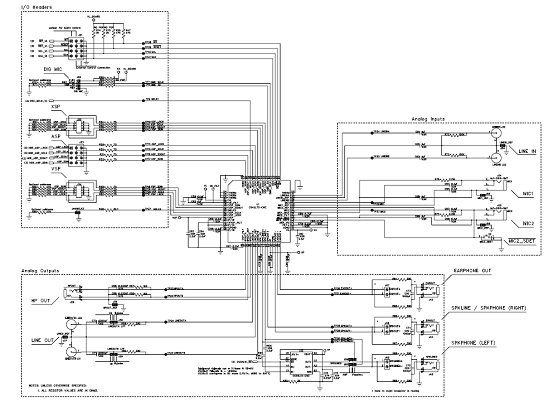
圖5.CS42L37評(píng)估板電路圖:CS42L73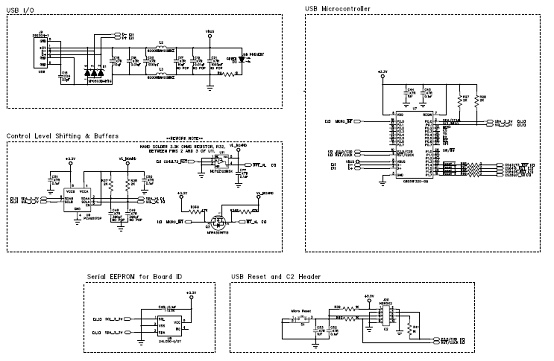
圖6.CS42L37評(píng)估板電路圖:USB和MCU
圖7.CS42L37評(píng)估板電路圖:S/PDIF接收器,發(fā)送器,時(shí)鐘緩沖器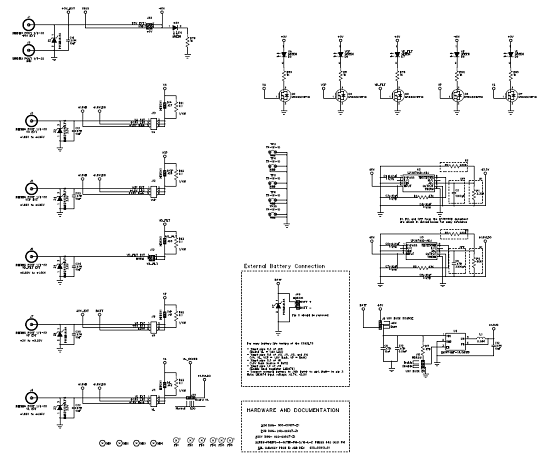
圖8.CS42L37評(píng)估板電路圖:電源
圖9.CS42L37智能音頻CODEC應(yīng)用框圖
 電子發(fā)燒友App
電子發(fā)燒友App











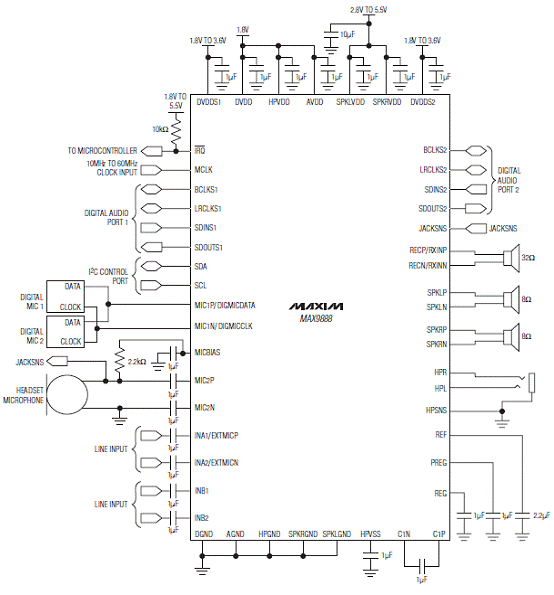




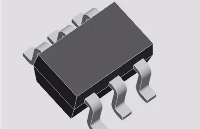










評(píng)論